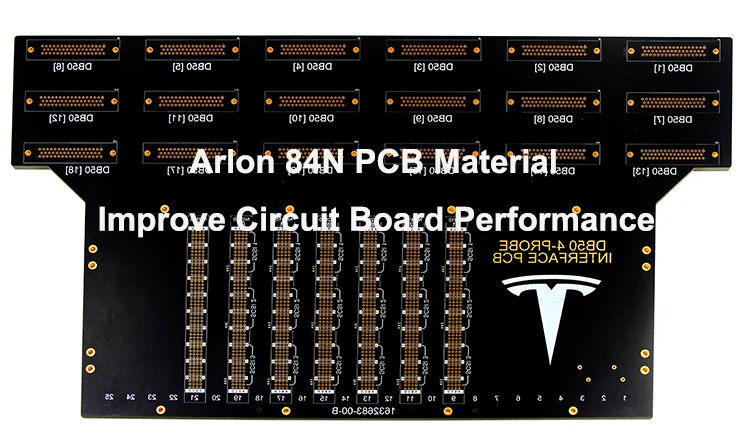
Rogers RO3035 is a PCB material designed for high-frequency applications where stable electrical properties are needed across a range of RF and microwave frequencies. Known for its low dissipation factor (Dk) and consistent performance, RO3035 is often chosen for projects requiring reliable operation in environments such as base stations, satellite communication systems, automotive radar, and wearable RF devices.
This material offers the flexibility needed for high-speed, high-density layouts, making it a practical option for miniaturized designs. It also provides engineers with the necessary stability to ensure signal integrity remains intact, even when working with intricate circuit designs. Its predictable behavior under various conditions can be a deciding factor when selecting the right material for your RF circuits.
In this guide, we’ll explore practical ways to apply Rogers RO3035 in RF circuit designs, compare it with other laminates such as RO4350B and RO3003, and walk through best practices that support consistent performance from layout to full production. From early-stage prototyping to scaled manufacturing, knowing how this material behaves under various design and process conditions can make a measurable difference in achieving project goals.
What Is Rogers RO3035 PCB?
Why Engineers Keep Choosing It for RF/Microwave Builds?
If you’ve been knee-deep in RF and microwave circuit layout, you’ve probably heard chatter around the Rogers RO3035 PCB material. And not just once. This laminate has quietly built a solid rep in high-frequency design circles—especially when performance has to stay tight across long production runs. No drama, just straight-up consistency.
This section breaks down exactly what this material is, how it stacks up against standard FR4, and why it’s frequently used in military-grade, telecom, and medical electronics. Ready to dig in? Let’s roll.
Introduction to Rogers RO3035 PCB Material Properties
Rogers RO3035 is built from a ceramic-filled PTFE composite—a combo that helps this material ride smoothly through high-frequency territory. Compared to glass-reinforced epoxy laminates, this one offers a much more stable dielectric behavior, even when the mercury rises or drops.
| Property | Typical Value | Test Condition |
| Dielectric Constant (Dk) | 3.50 ± 0.05 | @ 10 GHz / 23°C |
| Loss Tangent (Df) | 0.0015 | @ 10 GHz / 23°C |
| CTE (X/Y/Z) | 17 / 17 / 24 ppm/°C | Between 0–100°C |
| Moisture Absorption | 0.04% | ASTM D570 |
| Thermal Conductivity | 0.5 W/m·K |
With copper having a CTE around 17 ppm/°C too, RO3035’s X and Y-axis CTEs line up nicely—which means you’re not going to see a whole lot of layer shifting or pad lifting, even during reflow. That’s a win in any process engineer’s book.
Dielectric Constant, Loss Tangent, and Ceramic-Filled PTFE Explained
●Dk Stability: With a Dk hovering around 3.50 and barely budging under thermal stress, you can dial in tight impedance matches across multi-layer builds. That’s sweet when you’re routing a controlled-impedance stack with microstrip or stripline structures.
●Df Consistency: A loss tangent that low means RO3035 plays well in signal-sensitive zones—like when you’re dropping in power amps or RF filters.
●PTFE-Ceramic Mix: That ceramic fill ain’t just for show. It helps with mechanical robustness while still letting you process the board like a typical PTFE material, with just a little extra finesse in drilling and plasma treatment.
Benefits Over Conventional FR4 and Epoxy-Based Laminates
Now, nobody’s knocking FR4—it’s a workhorse. But when your designs push into the GHz range, FR4 starts to lose its footing.
●Lower Dielectric Loss: FR4’s loss tangent is usually around 0.020 at 10GHz. That’s over 15x higher than RO3035.
●Tighter Tolerances: You can count on RO3035 for narrow variance between lots—useful for OEMs who care about repeatability.
●Thermal Behavior: No warping, no weird delam around plated-through holes—especially when you’re layering up copper.
Plus, this stuff ships with predictable RF performance, so your simulation results won’t throw a curveball at final testing.
Material Comparison: Rogers RO3035 PCB vs RO4350B, RO3003, RO4003C
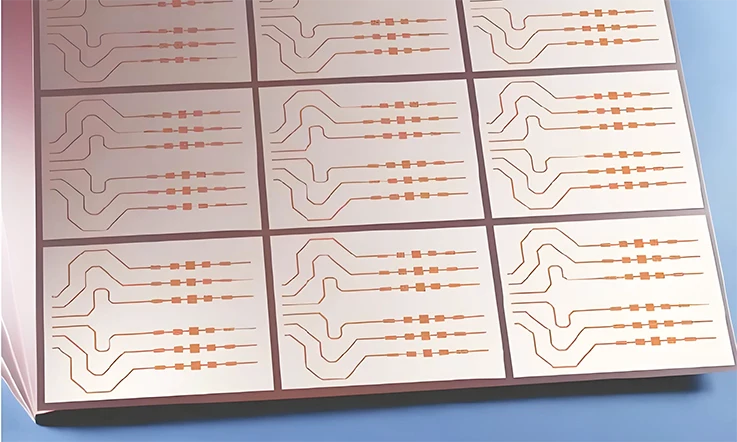
When selecting the right PCB material for RF applications, it’s necessary to consider the electrical properties, cost, and ease of manufacturing. Each of Rogers’ materials offers distinct characteristics that impact design outcomes and production processes. Understanding these differences can help optimize material selection for your specific needs.
Let’s compare these four materials based on core factors: dielectric properties, cost efficiency, and manufacturability.
Electrical Parameter Comparison Across Rogers Families
The dielectric constant (Dk), dissipation factor (Df), and thermal stability directly affect how a PCB behaves in high-frequency applications. Here’s how these materials compare:
1.RO3035: Featuring a Dk of 3.55± 0.05 at 10 GHz and a Df of around 0.0015, RO3035 is ideal for designs where low signal loss and precise impedance control are needed. Its low loss tangent makes it suitable for high-performance RF circuits, including automotive radar or high-power amplifiers.
2.RO4350B: The Dk of RO4350B ranges from 3.48 to 3.66 with a Df around 0.0031-0.0037. While it has a higher loss than RO3035, it is often selected for less demanding RF designs, where cost considerations are also a factor. This material works well for communication systems operating up to 6 GHz.
3.RO3003: With a Dk of 3.0± 0.04, RO3003 is often used in high-frequency designs, particularly in setups operating above 10 GHz. Its lower dielectric constant and minimal dissipation factor support consistent signal behavior, which aligns well with demands seen in satellite communication and defense-related RF systems.
4.RO4003C: Offering a Dk of 3.38± 0.05 and a Df of 0.0021-0.0027, RO4003C is a cost-effective option suitable for most RF applications. It performs well up to 10 GHz and is used in a variety of RF devices, including base stations and communication systems.
Each material is suited to different levels of performance and cost requirements. RO3035 and RO3003 are often used in high-performance applications, while RO4350B and RO4003C offer good performance at a more accessible price point.
Performance vs Cost vs Manufacturability Tradeoffs
Choosing the right material is not only about electrical performance but also about balancing cost and manufacturability. Here’s how each material compares:
1.RO3035: This material offers excellent performance but can be challenging to process due to the specialized fabrication techniques required. As a result, it is typically more expensive and may not be suitable for all production environments.
2.RO4350B: A more affordable option, RO4350B provides a solid balance between performance and cost. It’s widely used in general RF applications like base stations, Wi-Fi, and other communication systems. Its ease of processing and availability make it a common choice in the industry.
3.RO3003: While it supports high-frequency operation effectively, it tends to be more challenging and costly to process. This material often finds its way into specialized sectors such as aerospace and defense due to its alignment with the performance demands in those environments.
4.RO4003C: This is the most affordable material in the lineup and is relatively easy to manufacture. It’s suitable for standard RF applications and is often chosen when cost is a main factor, particularly in consumer electronics.
When considering these materials, it’s essential to weigh not only the electrical characteristics but also how they fit into your budget and production timeline. For high-performance, low-loss applications, RO3035 and RO3003 may be worth the extra cost. For less demanding designs, RO4350B and RO4003C offer a practical alternative.
Choosing the Right Material for Your RF Application
Selecting the right Rogers material depends on the specific needs of your RF application. Here’s a guide to help you decide:
●For High-Frequency Applications: RO3035 and RO3003 are the best choices for designs operating at frequencies above 10 GHz. They provide low loss and stable electrical properties, making them suitable for demanding RF circuits, such as radar and satellite communication.
●For General RF Communication: RO4350B and RO4003C are both well-suited for designs that operate below 6 GHz. These materials are commonly used in base stations, Wi-Fi routers, and other communication devices, where cost and manufacturability play a bigger role.
●For Cost-Effective Solutions: If you are working with a tight budget but still need a reliable RF material, RO4003C offers a good balance between price and performance. It’s widely available and used in a range of consumer electronics and standard RF communication systems.
Electrical, Thermal, and Mechanical Advantages of Rogers RO3035 PCB
When designing RF and microwave circuits, materials make or break performance — especially when signals are pushed into the multi-gigahertz zone. Rogers RO3035 PCB laminates have carved out a solid place in the engineering community by offering steady electrical behavior, low signal loss, and consistent structure under thermal and mechanical stress. Let’s take a deep dive into how it performs across the board and why so many high-frequency design engineers lean on this laminate when FR4 just doesn’t cut it.
Stable Dielectric Constant (Dk 3.5± 0.05) Across Frequencies
The dielectric constant of a material isn’t just a number — it controls impedance, signal timing, and power delivery in RF paths. With RO3035, the dielectric constant holds close to 3.50 ± 0.05, with very little drift even when frequencies climb. That’s a big deal when you’re trying to keep signal integrity across broadband systems or multi-layer stackups.
Engineers who’ve worked with low-cost FR4 know that inconsistent Dk leads to mismatched traces and test bench surprises. By contrast, Rogers RO3035 allows designers to simulate with more confidence, knowing that what they see in software will match the behavior on the actual board. Therefore, from radar front ends to phased array antennas, this level of predictability in dielectric response supports tighter design tolerances and more stable system performance.
Here’s a comparative table to illustrate the consistency:
| Material | Dk @ 10GHz | Dk Stability | Use Case Example |
| RO3035 | 3.50 ± 0.05 | High | Automotive radar modules |
| FR4 | ~4.2 | Low | Low-cost consumer electronics |
| RO4003C | 3.38 | Medium | Cellular base stations |
Low Dissipation Factor for Reduced Signal Loss
Another standout feature is the dissipation factor (Df) of just 0.0015 at 10 GHz, which is significantly lower than that of epoxy-based laminates. Lower Df translates to reduced insertion loss and sharper signal edges—especially useful in systems with narrowband filters, phase-sensitive circuits, or high-speed RF switches.
Let’s break that down:
●RO3035 Df: 0.0015 → Cleaner transmission with less energy turned into heat.
●FR4 Df: ~0.018 → Noticeable signal degradation, especially past 2 GHz.
In RF applications like LNA (Low Noise Amplifier) design, this low loss means your PCB won’t be the weak link in your signal chain.
Thermal Expansion and Dimensional Stability in Harsh Environments
RO3035 also shows favorable thermal and mechanical behavior, especially when environmental changes come into play. With a CTE (Coefficient of Thermal Expansion) of approximately 17 ppm/°C in the X and Y axes and 24 ppm/°C in the Z-axis, this material keeps things together during thermal cycling.
Why does that matter-
●When copper and laminate expand at different rates, you get micro-cracking or via failures.
●Matching CTE helps avoid warpage and fatigue over time.
●Particularly helpful in automotive radar systems, aerospace electronics, or outdoor 5G base stations.
Here’s a quick table:
| Property | RO3035 | FR4 |
| CTE X/Y (ppm/°C) | ~17 | ~15-18 |
| CTE Z (ppm/°C) | ~24 | ~60 |
| Tg (Glass Transition Temp) | >280°C | ~135°C |
| Application Stress Tolerance | High-temp zones | Moderate at best |
How Miniaturization and High-Density Layouts Use Rogers RO3035 PCB?
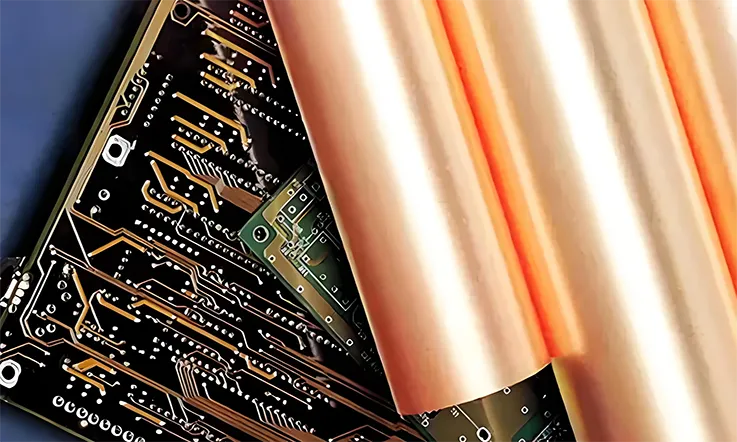
As RF designs push toward tighter footprints and higher operating frequencies, layout density and substrate consistency directly influence signal behavior. Rogers RO3035 laminate, known for its uniform dielectric response, supports engineers working on dense, miniaturized layouts while maintaining consistent impedance. From 10 mil cores in multi-band modules to microvias in six-layer stacks, RO3035 enables compact form factors without throwing off signal models or introducing unexpected results during board bring-up.
Thin-Core Rogers RO3035 (10mil/20mil) for Compact Design
When space is limited, thick cores add unnecessary bulk. Many teams working on high-density packaging prefer 10mil or 20mil RO3035 cores to manage overall stackup thickness while maintaining consistent Dk performance across microwave and millimeter-wave bands. With a Dk of 3.50 ±0.05 and a low dissipation factor (around 0.0015 at 10 GHz), this laminate supports accurate EM simulation results that closely reflect real-world measurements — no guesswork, no fudge factors.
In applications like 5G front-end modules or phased-array transceivers, even small impedance mismatches across tight bends and stubs can cause standing wave ratios to spike. Using a thin RO3035 core helps shrink trace widths and layer counts while staying inside tight impedance margins. Combine this with precision etching and plated microvias, and you’ve got a lean stack that still behaves the way your RF tools say it should.
So if you’re wrestling with height limits in a multi-band module or trying to sandwich more functionality into a thinner package, 10mil RO3035 won’t throw a wrench into your signal model.
Microvia Technology and HDI PCB Integration
Microvias and HDI layouts are the bread and butter of modern RF systems that cram everything into postage-stamp-sized real estate. Rogers RO3035 has the thermal and mechanical stability to handle laser-drilled microvias without resin cracking or delam risk. That’s a big deal when you’re stacking multiple build-up layers or routing differential pairs through tight via fields.
Its ceramic-filled PTFE base keeps via walls stable during multiple lamination cycles. That means less barrel distortion, fewer out-of-tolerance annular rings, and stronger interconnect reliability — especially in stacked via or via-in-pad designs. This comes in handy for layouts like compact radar modules, Wi-Fi 6E front-ends, or Bluetooth LE designs where routing density is through the roof.
If your HDI layout’s got more via-in-pad than copper pour, don’t gamble with glass-reinforced material — RO3035 gives you smoother vias, cleaner connections, and fewer re-drills.
Rogers 3035 in Wearable and Implantable RF Circuits
Wearable and implantable devices ask for more than just electrical performance — they need mechanical compliance, biocompatibility, and stable RF behavior under heat, flex, and environmental exposure. RO3035 doesn’t absorb moisture like glass-reinforced materials, and it holds up well under skin temp ranges and body motion.
For example, in implantable glucose monitors or neurostim devices operating around 2.4 GHz, the stable dielectric and low loss tangent make RO3035 a solid fit. Our designers often combine it with medical-grade encapsulation for Class III devices, especially when consistent RF transmission and low thermal expansion are part of the design checklist.
Its dimensional stability under mild flex loads also makes it a candidate for skin-worn devices like RF-enabled ECG patches or smart thermometers — especially those using rigid-flex hybrids where tight copper peel strength and minimal warpage help keep yields high.
Rogers RO3035 PCB in High-Speed and High-Power RF Designs
In high-speed and high-power RF designs, maintaining signal quality and managing heat buildup require careful attention to both electrical and thermal behavior. As operating frequencies increase and power levels rise, laminate properties can influence how well a design holds up under load. Rogers RO3035, a PTFE-based laminate, addresses these concerns with its low signal loss, stable dielectric properties, and consistent mechanical behavior across a wide range of operating conditions.
With its combination of electrical, thermal, and mechanical properties, RO3035 fits a variety of RF applications, from power amplifiers and automotive radar systems to base station equipment. Let’s explore how RO3035 performs across these demanding fields with real-world insights.
High-Power Amplifiers and Signal Booster Designs
Power amplifier designs require handling high power levels without introducing excessive heat or signal loss. At high power levels, even small inconsistencies in material properties can lead to significant performance variations. Rogers RO3035’s low dissipation factor (Df) of 0.0015 at 10 GHz helps mitigate this issue by minimizing signal loss, thus improving gain stability in power amplifier circuits.
Thermal management is another consideration in multi-stage amplifier designs. The material’s resistance to thermal cycling ensures that microstrip widths and impedance profiles remain consistent throughout various heating and cooling phases. This helps us avoid rework challenges typically encountered with lower-quality laminates, which may shift under heat cycles.
RO3035 is also well-suited for power amplifier circuits that use LDMOS or GaN transistors in the telecom frequency range, from 800 MHz to 6 GHz. Its dimensional stability and strong adhesion properties support tight-tolerance etching and plated-through vias, ensuring that complex designs can be fabricated without compromising on performance.
Rogers RO3035 PCB in Millimeter-Wave and 77GHz Automotive Radar
In automotive radar systems, especially those operating in millimeter-wave frequencies (24 GHz, 60 GHz, 77 GHz), the choice of PCB material has a direct impact on system performance. At these high frequencies, small variations in dielectric properties can cause signal loss, reducing range and reliability.
Rogers RO3035 is designed with high-frequency consistency in mind. Its dielectric constant of 3.5 ± 0.05 ensures signal propagation is maintained even at the challenging 77 GHz frequency, aligning well with simulation models. This stable behavior contributes to reliable detection performance in automotive radar systems.
Besides its electrical properties, RO3035 excels in mechanical reliability. Automotive radar systems must withstand vibration and thermal cycling due to the demanding conditions in vehicles. RO3035 maintains its structural integrity, ensuring the radar module continues to function without degradation or failure in these challenging environments.
Performance Data for Automotive Radar Systems-
| Property | Value | Unit | Description |
| Dielectric Constant (Dk) | 3.5 ± 0.05 | – | Consistent performance across millimeter-wave frequencies |
| Dissipation Factor (Df) | 0.0012 @ 77 GHz | – | Minimal signal loss at high frequencies |
| Thermal Coefficient of Dk | 25 ppm/°C | – | Stable performance across temperature fluctuations |
| Moisture Absorption | < 0.03% | % | Low moisture absorption for reliable performance |
| Thermal Shock Resistance | -40°C to +125°C | °C | Withstands thermal extremes encountered in automotive applications |
Performance in Base Stations and Low-PIM RF Circuits
Base stations involve complex RF circuitry, including filters, amplifiers, and duplexers, that must perform with minimal interference. Passive intermodulation (PIM) is a common issue that can cause signal distortion, especially when materials with inconsistent properties are used.
Rogers RO3035’s homogeneous PTFE-ceramic composition minimizes the potential for PIM by ensuring uniform copper adhesion and preventing the creation of micro-level dislocations. This makes it well-suited for low-noise, low-loss RF circuits in base stations, including those used in 5G NR, LTE-A, and older GSM/UMTS systems.
Moreover, base stations operate in environments with significant temperature variation. RO3035’s ability to maintain stable properties under these conditions ensures reliable operation and minimal performance variation.
Design Guidelines for Rogers RO3035 PCB in Controlled Impedance Routing
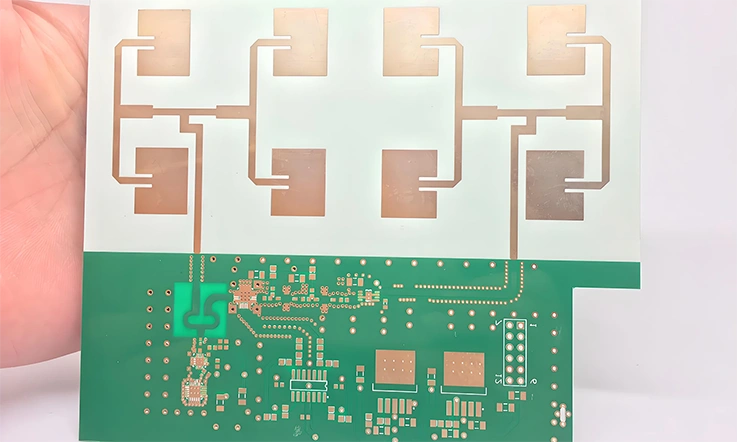
When RF boards push into multi-gigahertz ranges, impedance control becomes a balancing act between simulation accuracy, manufacturing repeatability, and material behavior. Rogers RO3035, with its low Dk variance and ceramic-filled PTFE base, offers a solid foundation for achieving consistent impedance targets across microstrip and stripline geometries. But getting it right takes more than just plugging numbers into a calculator — trace geometry, stack-up symmetry, and dielectric choice all shape signal behavior.
Below, we break down some hands-on design considerations when working with RO3035, especially for engineers dealing with tight trace tolerances, differential signaling, and layout constraints in high-frequency environments.
Trace Width Calculations and Differential Pair Design
Controlled impedance routing hinges on predictable trace widths and spacing — and Rogers RO3035 offers consistent Dk (3.50 ± 0.05), which simplifies trace dimensioning. That tight window makes it easier to dial in 50Ω single-ended and 100Ω differential traces using standard impedance calculators or tools like Polar SI9000 or Keysight ADS.
Still, don’t go in blind — simulation is your best friend here. When dealing with high-speed differential pairs, like USB 3.0, PCIe Gen4, or SerDes lanes above 10 Gbps, the copper roughness and solder mask openings also sneak into the equation. RO3035 comes with electrodeposited copper options and low-profile variants that help keep impedance within spec without introducing unpredictable insertion loss.
Sample Differential Pair Trace Calculation (RO3035, 0.508mm substrate):
| Parameter | Value |
| Substrate Thickness | 0.508 mm |
| Dielectric Constant (Dk) | 3.5 |
| Trace Width (W) | 0.22 mm |
| Gap Between Traces (S) | 0.18 mm |
| Calculated Impedance (Zdiff) | ≈ 100 Ω |
If your stackup is multilayer, keep an eye on return path consistency — via transitions and ground layer continuity can cause impedance bumps that show up in TDR plots. Don’t guess; test early and tweak with HFSS or Si9000 before taping out.
Dk Uniformity and PCB Layer Symmetry Optimization
Uniform Dk values across the board area are a big win in impedance control — and this is where RO3035’s ceramic-filled matrix pays off. It avoids the glass weave skew seen in traditional FR4 and offers a more uniform signal velocity across XY planes.
This uniformity becomes even more meaningful in differential routing where phase matching is sensitive. Uneven Dk across a pair can introduce skew, which leads to eye diagram collapse at high data rates.
In multilayer designs, symmetry across the central axis of the PCB helps manage warpage during reflow. A balanced structure (same material and copper weight above and below the core) reduces bow and twist — and RO3035, thanks to its dimensional stability, makes it easier to hold tight tolerances even on large panels.
Typical Stackup Consideration (4-layer example)-
| Layer | Description | Material Thickness |
| L1 | Signal (Microstrip) | 0.5 oz Copper |
| L2 | Ground Plane | 0.5 oz Copper |
| Core | RO3035 (Dk 3.5) | 0.508 mm |
| L3 | Power Plane | 0.5 oz Copper |
| L4 | Signal (Microstrip or Stripline) | 0.5 oz Copper |
Substrate Thickness Selection for Microstrip and Stripline Designs
RO3035 is available in a range of laminate thicknesses (e.g., 0.254 mm to 3.18 mm), which allows flexibility in both microstrip and stripline routing. Thinner substrates reduce parasitic inductance and work well in applications like antenna feeds or compact filters. Thicker cores, on the other hand, are preferred in stripline environments for better isolation and lower coupling between adjacent layers.
For microstrip, tighter thickness improves trace width resolution and reduces radiation loss, while in stripline configurations, the symmetrical dielectric environment supports more stable impedance, even as routing gets dense.
Substrate Thickness and Trace Width (50Ω target)-
| Substrate Thickness | Trace Width (50Ω) | Type |
| 0.254 mm | ~0.13 mm | Microstrip |
| 0.508 mm | ~0.25 mm | Microstrip |
| 0.762 mm | ~0.40 mm | Stripline |
Choose your thickness based on routing density, layer count, and EMI containment needs. Don’t forget to consider manufacturability — ultra-thin cores may increase risk of etching variance, while very thick substrates can make drilling and plating trickier.
Advanced Multilayer Stackup Techniques for Rogers RO3035 PCB
When pushing high-frequency designs beyond single-layer layouts, stackup planning can either dial in performance or throw the entire RF balance off-kilter. Rogers RO3035 laminate, with its ceramic-filled PTFE base and stable Dk of 3.5, supports the development of multi-layer RF boards that maintain electrical consistency—without the headaches of resin-rich zones or erratic copper behavior. In cases involving FR4 integration for hybrid configurations or tuning controlled impedance across specific signal planes, dialing in the right stackup helps reduce rework and keeps the results consistent from batch to batch.
Let’s break down the go-to techniques engineers use to work with RO3035 in multilayer layouts, based on real fab house practices and layout considerations.
Hybrid PCB Stackup: RO3035 with FR4 Integration
Blending RO3035 with FR4 is a common play in mixed-signal or RF/digital combo boards. It lets you place your sensitive RF lines on RO3035 layers while handling power and low-speed signals on standard FR4 — keeping costs and processing under control. But mixing materials like this isn’t plug-and-play.
RO3035 has a Dk of 3.5 ± 0.05, while FR4 typically ranges between 4.2 and 4.8. That gap can skew impedance if you’re not careful. We usually dedicate the outer or RF-critical layers to RO3035 and bury digital lines in FR4 zones. The trick is making sure transitions (like via stubs or blind/buried vias) don’t create mismatched impedance paths or throw off return current.
Example Stackup (4-Layer Hybrid):
| Layer | Material | Function |
| Top | RO3035 | RF traces (microstrip) |
| L2 | FR4 Core | Power/Ground plane |
| L3 | FR4 Core | Digital signals |
| Bottom | RO3035 | RF ground or stripline ref |
Bonding Materials and Dielectric Compatibility
RO3035 isn’t your average laminate — it needs compatible bonding prepregs when layered with other materials or during lamination cycles. Popular choices include Rogers 3001 bonding film or thermoset adhesives designed to match the PTFE base. Using standard epoxy-based bondply like you’d find in a typical FR4 layup? That’s asking for delamination or a warped board after reflow.
The goal is to keep expansion coefficients and dielectric transitions tight enough that signal integrity doesn’t tank at layer interfaces. Matching Z-axis expansion between bondply and laminate avoids stress fractures during lead-free solder reflow, especially in automotive or telecom applications that face repeated heat cycles.
Common Material Pairings:
| Core Laminate | Bonding Material | Notes |
| RO3035 | 3001 Film | Matched Dk/Df, low loss |
| RO3035 | Thermoset prepreg | Use with multi-stage lamination |
| RO3035 + FR4 | Custom stackup | Requires impedance re-calculation |
Impedance Control and Signal Integrity Across Layers
Dk consistency is a big deal when dialing in impedance across high-frequency layers — and RO3035 keeps it steady from the low GHz range up into the microwave bands. This makes microstrip and stripline layout more straightforward, especially when you’re routing across stacked RF sections like couplers, filters, or signal splitters. No detours, no chasing unexpected shifts in the lab — what you model is far more likely to show up cleanly on your TDR or VNA screen.
When designing stripline layers within a RO3035 stackup, make sure to keep symmetry in check — even minor variations in trace spacing or copper-to-copper distances can throw impedance off. And while RO3035’s low Df (~0.0013 at 10 GHz) helps reduce signal loss, mismatched reference planes or poor via stubbing can still introduce headaches.
Sample Impedance Chart (RO3035):
| Structure | Trace Width (mil) | Dielectric Height (mil) | Target Impedance (Ω) |
| Microstrip | 12 | 8 | 50 |
| Stripline | 10 | 6 (centered) | 50 |
| Differential | 7/7 spacing 6 mil | 8 | 100 |
Manufacturing Process for Rogers RO3035 PCB
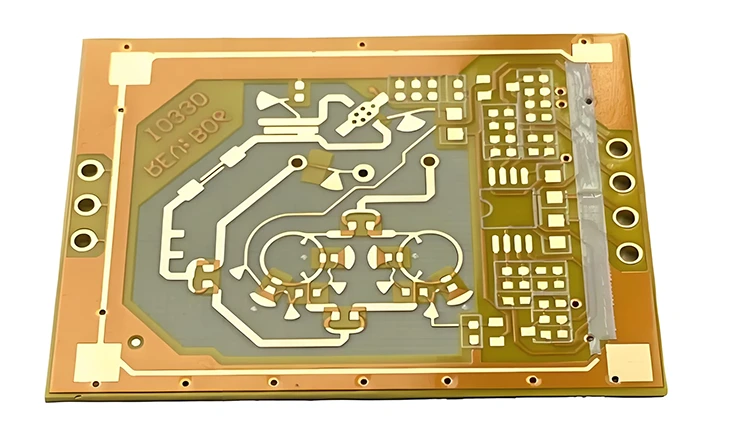
Rogers RO3035 is a ceramic-filled PTFE laminate, which brings a distinct set of processing behaviors compared to epoxy-based materials like FR4. When this laminate hits the fabrication floor, treating it like standard prepreg or woven-glass material is a one-way ticket to yield issues. To avoid warping, resin recession, copper lift, or hole wall integrity problems, every step—from drilling to plating—needs to follow a tailored approach.
Drilling, Plating, and Etching Considerations
PTFE-based laminates don’t respond well to the same mechanical forces used on glass-reinforced boards. RO3035’s low hardness and non-reinforced core call for reduced spindle speeds and minimized chip loads during mechanical drilling. Overspeeding tends to smear PTFE into the hole walls, leading to inconsistent copper adhesion during plating. Using a new drill bit (120–140° point angle, 0.1 mm oversized) and proper entry/exit material makes a big difference.
Plating through holes in RO3035 is more demanding. Due to its inert and non-polar surface, pre-treatment steps like plasma or permanganate desmear are often necessary to promote proper adhesion. Failing to cleanly activate the hole wall surface can result in copper fall-out during thermal cycling or operation.
Etching precision matters too. The ceramic filler gives RO3035 excellent dimensional stability, but care still needs to be taken with etchback control—especially for fine-line RF traces. Don’t count on FR4 etch parameters to apply here.
Try this: For plated-through-hole quality, run a controlled plasma cycle with oxygen/nitrogen blend for surface activation. Then go with direct metallization or a catalytic palladium-based process, depending on your line setup.
Lamination Pressure and Temperature Profiling
Laminating RO3035 isn’t a set-it-and-forget-it job. The PTFE matrix responds very differently to pressure and heat than thermoset materials. Excess pressure during lamination (above 300 psi) can deform the substrate or cause the resin to cold-flow, especially when paired with low-viscosity adhesives. Laminate shrinkage post-lamination can also cause misregistration if thermal control is sloppy.
A typical process window that works includes:
●Pre-bake: 1–2 hrs at 150°C to drive off moisture
●Pressing temperature: 200–220°C
●Pressure: 200–275 psi depending on the adhesive
●Ramp rate: <2.5°C/min to prevent thermal shock
●Cool-down under pressure to avoid warping
Under-cured bonding films or uneven temperature profiles will show up later as delamination or dimensional drift—especially after reflow or thermal stress testing.
Pro tip: Avoid compressing mixed-material stackups (like RO3035 and FR4) without symmetrical construction. PTFE and epoxy expand at different rates, and that mismatch tends to show up as bow and twist if the stack is unbalanced.
Surface Finishes: ENIG, Immersion Silver, OSP Compatibility
Surface finish selection needs to account for both RF performance and thermal durability. ENIG (Electroless Nickel Immersion Gold) is often used on RO3035 boards, especially for mixed-signal designs. It gives decent flatness for BGA assembly and helps reduce contact wear. But keep in mind, nickel can introduce slight signal reflection above 10 GHz—worth noting for ultra-low-loss builds.
Immersion silver is cleaner from an RF standpoint and better suited to stripline or edge-coupled lines where surface roughness and conductivity have more weight. It also simplifies rework but has limited shelf life and needs to be stored carefully.
OSP works but only when the board isn’t exposed to multiple soldering passes or long-term storage. PTFE substrates like RO3035 don’t interact with OSP as well as FR4 does, so you’ll see better yields if the solder mask is dialed in and copper topography is well-managed.
How to Choose the Right Rogers 3035 PCB Manufacturer?
Selecting a manufacturer for Rogers 3035 PCBs calls for a close look at several practical factors to make sure you’re teaming up with a vendor who can meet performance expectations and handle the material properly.
Manufacturing Capabilities
Working with a manufacturer that consistently meets IPC standards shows they have the process control and technical know-how to handle demanding PCB builds. This kind of track record reduces the chances of setbacks during fabrication or downstream assembly.
PCB Assembly Expertise
Experience matters. Choose a manufacturer that has extensive experience in PCB assembly, specifically with Rogers 3035 material. Their expertise in assembling these boards will contribute to the quality and performance of your final product, minimizing the risk of issues down the line.
Use of High-Quality Materials
Ensure that the manufacturer uses top-tier materials when producing Rogers 3035 PCBs. High-quality, genuine materials are core to achieving a durable and reliable PCB laminate, ensuring long-term stability and performance.
Technical Support
A good manufacturer will provide ongoing technical support throughout the process. Having access to expert technicians who can offer advice and resolve any issues quickly ensures smooth communication and efficient problem-solving.
RoHS Certification
Confirm that the manufacturer is RoHS certified. This indicates alignment with current environmental regulations and the use of lead-free materials and processes. For projects targeting global markets or meeting specific compliance requirements, this certification helps streamline approval steps and reduce regulatory headaches later on.
Customer Service
Effective customer service is a must. Choose a manufacturer with a responsive and attentive customer support team that can address any concerns or queries promptly and efficiently, ensuring your needs are always met.
Why Engineers and OEMs Trust Us for Rogers RO3035 PCB Fabrication?
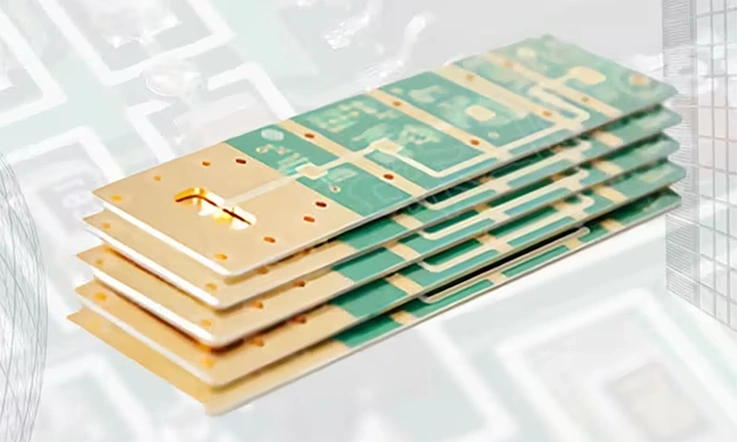
When it comes to designing RF circuits, reliability and performance are central to achieving the desired outcomes. Therefore, we can provide precise manufacturing for high-frequency PCB like Rogers RO3035. With years of experience and a strong manufacturing capability, we focus on delivering precise, reliable results tailored to each customer’s needs, whether for prototypes or large-scale production.
At our facility, we handle the unique requirements of Rogers RO3035 with advanced processes and technologies, ensuring your designs meet all performance and manufacturability requirements without compromise. Here are the reasons why our clients rely on us to fabricate their Rogers RO3035 PCBs.
High-Frequency PCB Manufacturing Capabilities in China
Our manufacturing plant in China is equipped with state-of-the-art facilities capable of handling the intricacies of high-frequency PCB fabrication. Specialized equipment and rigorous process controls are used to ensure that every PCB is built to meet the high standards required for RF applications.
Manufacturing Process Overview for High-Frequency RO3035 PCBs-
| Process Step | Specifications | Notes |
| Drilling | Laser drilling for precise vias | Ensures signal integrity at high frequencies |
| Etching | Fine-line etching (≤ 4 mil) | Ensures optimal trace width control for signal paths |
| Copper Plating | Uniform copper plating | Guarantees minimal signal interference |
| Via Plating | Electroless nickel immersion gold (ENIG) | Helps minimize signal loss in high-frequency designs |
| Lamination | Temperature-controlled lamination | Creates uniform layer bonding for stable electrical performance |
This process ensures the manufacture of boards that meet the required performance standards in a variety of RF applications.
Expert Engineering Support and Material Consulting
Our engineering team offers deep knowledge in material selection and circuit board manufacturing, design optimization, and ensuring that each PCB meets the specific needs of high-frequency applications. Rogers RO3035 has been selected for its low dielectric loss and stable Dk, making it reliable for minimizing signal distortion and enhancing signal integrity in RF designs.
We work directly with our clients to provide material consulting and PCB fabrication, particularly when custom solutions are necessary. For example, in a recent automotive radar application, we helped our client determine the PCB trace width to account for the different expansion rates between Rogers RO3035 and FR4 materials, optimizing the design for signal stability.
Fast Prototyping to Mass Production with Rogers PCB Materials
Our manufacturing capabilities support both quick-turn prototypes and large-volume production with Rogers RO3035, giving customers a smooth path from design to final product. From small test batches to full-scale runs, our processes are built to handle varying production timelines with consistency and accuracy.
Our quick-turn prototyping service is particularly beneficial when the design cycle is tight. This was demonstrated when we worked with a client in the wearable electronics space, where fast turnaround allowed them to validate their designs and meet tight deadlines. By streamlining production, we helped reduce their time to market.
Prototyping Timeline and Efficiency-
| Stage | Turnaround Time | Notes |
| Prototype Design Review | 1–2 days | Design feedback and optimization |
| Prototype Fabrication | 5–7 days | Fast fabrication for initial tests |
| Production Ramp-Up | 10–14 days | Efficient scale-up for larger orders |
Rogers RO3035 & FAQ
1.What is the surface roughness of Rogers RO3035?
The surface roughness of Rogers RO3035 is typically smooth, which helps maintain signal integrity in RF applications.
2.What is the impact of using Rogers RO3035 in high-density interconnect (HDI) designs?
Rogers RO3035 can be integrated into HDI designs, maintaining signal integrity and reducing signal loss in compact layouts.
3.Can Rogers RO3035 be used for medical device applications?
Yes, its stability and reliability make it an option for RF circuits used in medical equipment.
4.What are the best practices for designing impedance-controlled circuits with Rogers RO3035?
Proper trace width calculations, differential pair routing, and layer stacking are essential to ensure proper impedance control with Rogers RO3035.
Our services
Rogers PCB Laminates & Series





